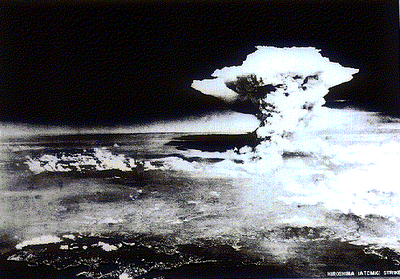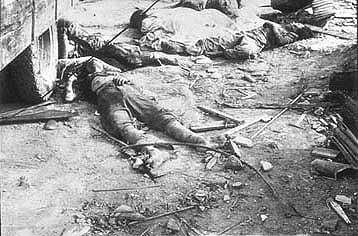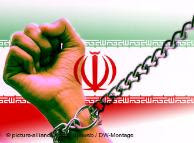PHOTOGRAPHS OF
HIROSHIMA AND NAGASAKI
1. The Huge Atomic Cloud / The Mushroom Cloud Blowing Up
The atomic cloud (mushroom cloud) produced just after the burst is one of the most intensive characteristics of the A-bomb explosion.
The Hiroshima Meteorological Observatory reported that just after the flash, black smoke rose from the ground up to the sky reaching an altitude of several thousand meters, and covered the whole city. When the fireball disappeared, the angry clouds, like grey smoke, rose and reached an altitude of 8,000 meters in 5 minutes after the explosion.
One of the EnolaGay crew recorded in his flight diary, "9:00a.m.....Clouds were observed. Altitude of 12,000 meters or more." From a distance the cloud formation looked like a mushroom growing out of the ground, with white cloud at the top and yellowish clouds enveloping reddish-black clouds, creating a color that cannot be described as while, black, red or yellow.
In Nagasaki, from an observation point at the air-raid lookout post on Kouyagi Island located about 8 kilometers south of the city, just after the flash it appeared that a huge fireball covered the city, as if it were suppressing the city from the sky. Around the fireball there was a doughnut-shaped ring from the midst of which black smoke and flames rose up to the sky in an instant. The ring of the flames did not initially reach the ground. When the fireball scattered with a flash, the city was covered with darkness. The smoke rising from the midst of the ring, glittering in colors of red, white and yellow, reached an altitude of 8,000 meters in only 3 or 4 seconds.
After reaching an altitude of 8,000 meters, the smoke ascended more slowly and took about 30 seconds to reach an altitude of 12,000 meters. Then, the mass of smoke gradually discolored and scattered in wads of white clouds.
2. Hiroshima Was Burnt To Ashes
The building was the former Hiroshima Prefecture Industrial Promotion Hall, Where special products of Hiroshima were exhibited and various gatherings were held until the A-bomb was dropped. Since it was located just under thehypocenter, blast pressure was vertically exerted on the bulding and only the dome-shaped framework and part of the outer wall remained. It has come to be called "the A-bomb Dome", and it has come to symbolize to the people of the world "No More Hiroshimas". As years passed, however, the ruin has deteriorated further due to winds and rain. A civic movement was started calling for permanent preservation of the A-bomb Dome, and money was contributed from all over Japan, not to mention from Hiroshima. Within a year after the fund-raising campaign was started, the restoration funds had been collected. In August 1967, the reinforcing construction was completed. That is why the present A-bomb Dome gives a different impression from that in the photograph.
The bridge located to the south (the other side) of the Dome is Motoyasu Bridge, and the area to the west (right) of the bridge is the present Peace Park. The hill a little right from the center is Ninoshima (called small Mt.Fuji), which is about 9 kilometers from the spot where the photograph was taken.
3. Victimes Who Escaped Hell On Earth
August 6. 1945. This is one of the six photographs recording the disaster of Hiroshima. A precious photograph taken only three hours or so after the explosion.
Towards the right and beyond is the center of Hiroshima City, and the raging fire is creeping up. Both ends of this bridge, which was the longest one in Hiroshima at that time, were filled with A-bomb victims. Many of them were students of the Hiroshima Prefectural Daiichi Middle School and the Hiroshima Girls' Commercial School who were exposed to and injured by the A-bomb while participating in the demolition of buildings.
Mr. Matsushige, who was a news cameraman then, wrote in the "Hiroshima Tokuho", issued on August 6, 1980, based on his experience, ads follows:
"...in front of the police box of Senda township located at the west end of Miyuki Bridge, a policeman took off the lid of an oil can and started to give first aid treatment to the people with burns, but the number of the injured increased rapidly. I thought this must be photographed and held the camera in position. The scene Isaw through the finder was too cruel. Among the hundreds of injured persons of whom you cannnot tell the difference between male and female, there were children screaming 'It's hot, it's hot!' and infants crying over the body of their mother who appeared to be already dead. I tried to pull myself together by telling myself that I'm a news cameraman, and it is my duty and privilege to take a photograph, even if it is just one, and even if people take me as a devil or a cold-hearted man. I finally managed to press the shutter, but when I looked the finder for the second time, the object was blurred by tears."
Because of the atomic bombing, there were no newspaper reports in hiroshima for August 7th and 8th of 1945. The "The Hiroshima Tokuho" (the phantom newspaper) was published on August 6, 1980, faithfully reflecting the feeling of that time based on the news collected by three reporters and a cameraman who heated toward the hypocenter immediately after the detonation of the A-bomb.
4. 300-Year-Old Camphor Tree Uprooted By The Blast
In the precincts of the Kokutaiji Temple, the big camphor tree, said to be over 300 years old was designated as a natural monument. Its branches and thick leaves provided a place of comfort for the passers-by during summertime. Its roots spread out in all directions for 300 meters, and the street car lines shown on the left in the photograph had to avoid the tree, which formed an archway over the sidewalk.
By a blast pressure of 19 tons per square meter, the tree was uprooted. Also, hundreds of tombstones were knocked in all directions by the complex flow of wind from the blast.
The white building seen on the extreme right is the Hiroshima branch of the Bank of Japan. Because it was built of strong ferro-concrete and stonework, the exterior remained uncollapsed but the interior burned.
5. A Building Brought To Knees By The Blast
This was a clock store located in Hiroshima's central business quarters called the 'Hondori', which is still a bustling street. The upper part was the clock tower which had been telling the time to passers-by, until the explosion.
The first floor shown in the photograph was the second floor. This two-storied building was of a strusture like a match box with no central pillar, so when it received the blast pressure from the side, the first floor was crushed and the building sank into itself. Hence, the second floor became the first floor, and the building leaned toward the side away from of the blast.
There were many buildings of ferro-concrete structure in Hiroshima, mostly in the vicinity of the hypocenter. According to a survey, these durable buildings were only destroyed if they were within 500 meters of the hypocenter. Buildings of earthquake-proof construction were damaged only on the inside. However, many buildings situated beyond 500 meters were essentially destroyed too, as in the case of this clock store situated farther than 500 meters.
6. Disaster Near The Hypocenter
Around the Matsuyama-cho intersection which is close to the hypocenter, victimswere burned to death in their last gesture grasping at the air or trying to escape. Everything that burns was burnt. Roof tiles were crushed into small pieces and scattered all over, air-raid shelters and street cars were burned and ruined. All tell the miserable story without words.
In the Record of the Nagasaki A-bomb War Disaster, the situation in Matsuyama township is described as follows:
"A huge fireball formed in the sky. Directly beneath it is Matsuyama township. Together with the flash came the heat rays and blast, which instantly destroyed everything on earth, and those in the area fell unconscious and were crushed to death. Then they were blown up in the air and hurled back to the ground. The roaring flames burned those caught under the structures who were crying or groaning for help.
When the fire burnt itself out, there appeared a completely changed, vast, colorless world that made you think it was the end of life on earth. In a heap of ashes lay the debris of the disaster and charred trees, presenting a gruesome scene. The whole city became extinct. Citizens who were in Matsuyama township, the hypocenter, were all killed instantly, excepting a child who was in an air-raid shelter."
7. The Urakami Cathedral Destroyed In An Instant
The cathedral collapsed at the burst of the A-bomb and scores cf believers died, sharing the same fate. Then, fire broke out. It is said that the remains of the cathedral continued to further collapse with eerie thuds even after dark. It is also said that there were 1,400 believers in Urakami at the time of the bombing, and 850 were killed by the A-bomb.
In the ruins of the cathedlal, there were many stone statues of the saints in the heaps of broken bricks and stones. The photograph shows part of the outer wall of the south entrance where the statues of the Holy Mother and Saint ,John lie chat,red by the heat rays. Also, the shadow in the lower left of the photograph shows that the largest twin tower in the Orient fully received the blast and was shifted 8 centimeters from the foundation stone.
The building. of this cathedral began in 1985 and it took 30 years to be completed in Urakami, a village then, where the believers have kept their faith since Christianity was introduced to Japan, and even through the years of the Edo period(1603-1867) when Christianity was prohibited. The building employed the Romanesque style, using stones and bricks. This cathedral had a floor space of 1,162 sq. meters and tower 26 meters high. The current LTr.akami Cathedral was built in 1959. Part of the destroyed cathedral is preserved at the hypocenter.
8. A Factory Destroyed By The Blast
The steel framework of this factory was broken and bent in a mess as if it were made from a pliable material. The concrete base supporting the steel frame was shoved by the blast. This is testament to how frightful the blast pressure was. It is estimated that this factory was subjected to a wind velocity of 200 meters per second arid a wind pressure of 10 tons per square meter.
Until the Very moment of the explosion, there was an array of machine tools in the factory, and a number of overhead cranes were busily operating. Most of the workers Were crushed to death.
On August 9, it is recorded that 1,721 persons came to work, among whom 1,019 died and 149 were seriously injured. The rate of casualties was 68%.
A worker Who miraculously kept his life said: "I was talking about work with my colleague, but in a moment he was killed instantly by a crane which crushed half of his body. It was a shocking sight and a horrible way to die --his head was smashed, his belly torn and his bowels ballooned." This photograph shows where many such tragedies took place.
9. Shiroyama Primary School Leveled By The Blast
Shiroyalna Primary School is the primary school nearest to the hypocenter. Built on a hill surrounded by beautiful woods, this was the most modern ferro-concreate school building in Nagasaki. The Shiroyama township was a neathly-planned, quite residential district, but with one flash of the A-bomb, the school, homes and the woods were reduced to rubble.
According to the records of April 1945, this school had 32 classrooms, 1,500 pupils and 37 teachers and staffs. Since an air-raid alert was announced on that day, the pupils were s(nt home. Those who remained were 32 teachers (including a child of one of the teachers), 44 students of the Gakuto Hokokutai, and 75 workers from the Mitsubishi Heiki Seisakusho. A total of 151 persons.
Of the 151 persons, 52 were instantly killed by the heat rays and the enormous wind pressure, and 79 died later. A total of 131 victims accounts for a death rate of 87%. Of the 1,500 pupils who were at a home, it is estimated that about 1,400 were killed.







































